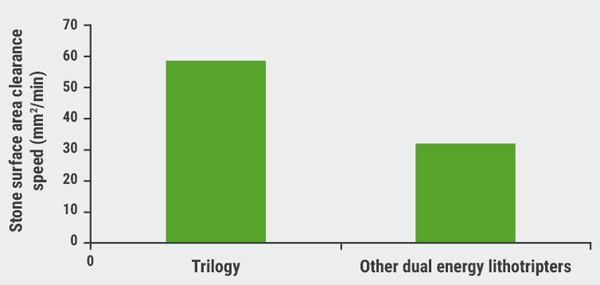Available PCNL options include pneumatic, ultrasonic, and electrohydraulic lithotripsy and laser, each having its own positive and negative attributes. Most modern lithotripters combine energy sources; however, there is no general consensus as to the single best modality for stone breakage. Dr Wiseman compared the newer lithotripters currently available. Specifically, the Trilogy is a single-probe device that delivers both ultrasonic and electromagnetic ballistic energy, with suction capability as well.
When compared with other devices in 10 European centres in a prospective non-randomised study, run by the EAU Section of Uro-Technology (ESUT), the Trilogy was found to have superior stone clearance time and clearance rate, and it required no conversions to another device. The published clinical stone clearance rates for other dual energy lithotripters based on surface area for other lithotripters (24-32.3 mm2/min), and the 3D calculated stone volume were compared with the single published series for the Trilogy (591 mm3/min). Objective measures were stone clearance rate, device malfunction, stone-free rate, and complications. In addition, surgeons scored subjective parameters for ergonomic and device effectiveness on a visual analogue 1-10 scale (10=extremely ergonomic/effective), and compared it with their usual lithotripter (10=extremely effective).
The study included 53 patients; 25 participants were female and the mean age was 57 years (range 16-84). The mean stone clearance rate was 58 mm2/minute, or 1,202 mm3/minute based on calculated 3D stone volume, double the clearance rate of previously published rates (see Figure). The stone-free rate on fluoroscopy screening at the end of the case was 75%. The subjective ergonomic score was 8.2, suction effectiveness was rated 9.4, with 9.3 for combination effectiveness, and 9.13 for overall effectiveness compared with the lithotripter most commonly used previously.
Figure: Comparative stone surface area clearance rate [2]

Figure kindly provided by Dr Wiseman.
With regard to safety, 3 patients required a blood transfusion, 2 patients developed post-procedure sepsis, 2 required JJ stent placement after clamping or removal of nephrostomy tube, and 1 patient had a prolonged bleed. Probes broke during 5 procedures (9%), and there were 2 other device-related complications, none of which required using a different lithotripter, and all of which were attributed to the lack of familiarity of using a new device.
Long-term follow up is awaited, but the device was perceived to be highly effective overall. The stone removal efficiency of Trilogy is almost 100% greater compared with published data on other lithotripters. Disadvantages include the 1,200 gram weight of the device.
- Wiseman O. EAU20 Virtual Congress, 17-26 July 2020, Plenary session 06 - Stones: The role of innovation.
Posted on
Previous Article
« New urosepsis data from the SERPENS study Next Article
Letter from the Editor »
« New urosepsis data from the SERPENS study Next Article
Letter from the Editor »
Table of Contents: EAU 2020
Featured articles
Surgical Techniques and Safety
The new adjustable artificial sphincter victo: Surgical technique and results after a follow-up of more than one year
New urosepsis data from the SERPENS study
Stones
Intra-operative cone-beam computed tomography for detecting residual stones in percutaneous nephrolithotomy
Pressure and temperature: do high-power lasers pose a threat?
Radiation stewardship for patient and endourologist
New lithotripter data: improved stone clearance
Renal Cancer
Beyond the limits of ultrasound: Three dimensional augmented reality robot assisted partial nephrectomy (3D AR-RAPN) for complex renal masses
Imaging guided surgery with augmented reality for robotic partial nephrectomy
KEYNOTE-426: no QoL differences pembrolizumab + axitinib versus sunitinib
Debate: upfront cytoreductive nephrectomy or not?
Robotic-assisted partial nephrectomy: lower morbidity
Bladder Cancer
Reduced BCG frequency, faster NMIBC recurrence
Nadofaragene firadenovec effective in BCG-unresponsive papillary NMIBC
Understanding MIBC biology for novel treatment options
Prostate Cancer & Imaging
Transperineal laser ablation of prostate
Prostatectomy: R-LRPE better than LRPE for continence
PSMA PET-CT staging is 27% more accurate
Docetaxel + hormonal therapy: improved prostate cancer PFS
ARAMIS subgroup analysis: darolutamide benefits across PSADT groups
Large patient-driven survey reveals QoL issues after prostate cancer treatment
Targeting steroid sulphatase in resistant prostate cancer cells
Good tolerance of post-RP radiotherapy ± short-term ADT
BPH & LUTS
Minimizing post-operative stress urinary incontinence after HoLEP: Our preliminary experience and short-term results of ‘’En Bloc’’ technique with early apical release
LUTS 2-year outcomes: aquablation versus TURP
HoLEP versus PVP in prospective randomised trial
Testis Cancer & Andrology
Peyronie’s disease: surgical options
Infertility and testis cancer risk: causal or association?
32% more men complain of reduced sex drive in 2019 versus 2009
Related Articles
© 2024 Medicom Medical Publishers. All rights reserved. Terms and Conditions | Privacy Policy
HEAD OFFICE
Laarderhoogtweg 25
1101 EB Amsterdam
The Netherlands
T: +31 85 4012 560
E: publishers@medicom-publishers.com

